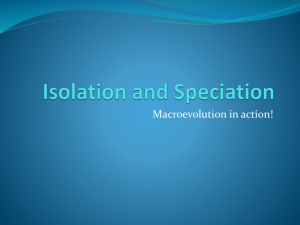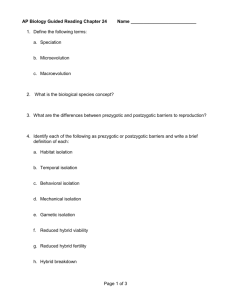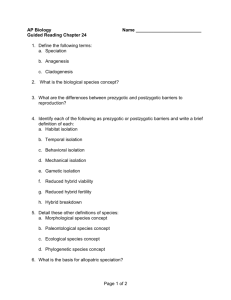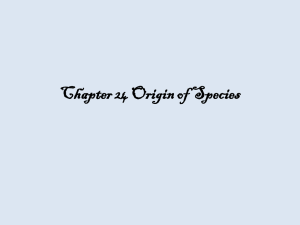species
advertisement
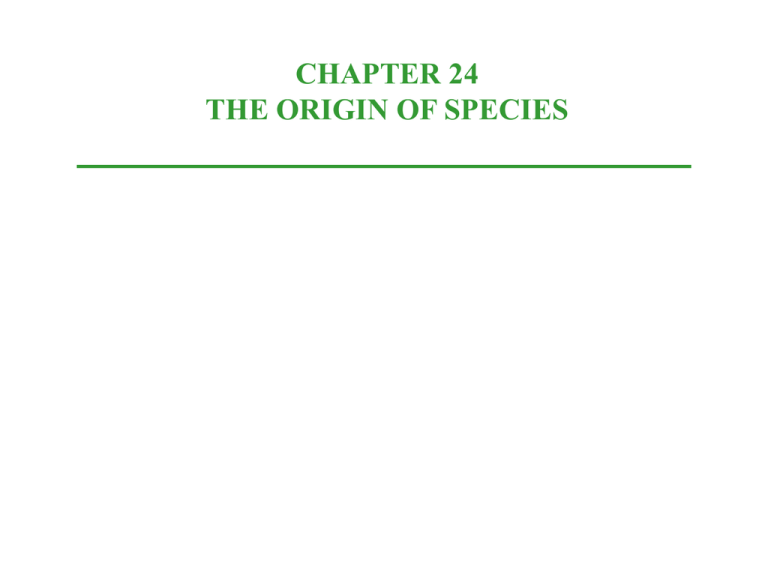
CHAPTER 24 THE ORIGIN OF SPECIES Introduction • Macroevolution- the origin of new taxonomic groups (new species, new genera, new families, new kingdoms) • How is this different from microevolution? • Cladogenesis• Anagenesis- the branching evolution, accumulation of changes the budding of one or associated with the more new species from transformation of one a parent species. species into another. The biological species concept emphasizes reproductive isolation • A species is a population or group of populations whose members have the potential to interbreed with each other in nature to produce viable, fertile offspring, but who cannot produce viable, fertile offspring with members of other species. • Species are based on interfertility, not physical similarity. Prezygotic and postzygotic barriers isolate the gene pools of biological species • Prezygotic barriers impede mating between species or hinder fertilization of ova if members of different species attempt to mate. • Habitat isolation. Two organisms that use different habitats even in the same geographic area are unlikely to encounter each other to even attempt mating. • Behavioral isolation. Many species use elaborate behaviors unique to a species to attract mates. • Temporal isolation. Two species that breed during different times of day, different seasons, or different years cannot mix gametes. • Mechanical isolation. Closely related species may attempt to mate but fail because they are anatomically incompatible and transfer of sperm is not possible. • Gametic isolation occurs when gametes of two species do not form a zygote because of incompatibilities preventing fusion or other mechanisms. • If a sperm from one species does fertilize the ovum of anotherPostzygotic barriers prevent the hybrid zygote from developing into a viable, fertile adult. • Reduced hybrid viability. Genetic incompatibility between the two species may abort the development of the hybrid at some embryonic stage or produce frail offspring. • Reduced hybrid fertility. Even if the hybrid offspring are vigorous, the hybrids may be infertile and the hybrid cannot backbreed with either parental species. • Hybrid breakdown. In some cases, first generation hybrids are viable and fertile. • However, when they mate with either parent species or with each other, the next generation is feeble or sterile. Modes of Speciation • Allopatric speciationgeographic separation of populations restricts gene flow. • Sympatric speciationspeciation occurs in geographically overlapping populations when biological factors, such as chromosomal changes and nonrandom mating, reduce gene flow. Allopatric speciation: geographic barriers can lead to the origin of species: • Several geological processes can fragment a population into two or more isolated populations. • The evolution of many diversely-adapted species from a common ancestor is called an adaptive radiation. Sympatric speciation: a new species can originate in the geographic midst of the parent species • In sympatric speciation, new species arise within the range of the parent populations. • In plants, sympatric speciation can result from accidents during cell division that result in extra sets of chromosomes, a mutant condition known as polyploidy. • An individual can have more than two sets of chromosomes from a single species if a failure in meiosis results in a tetraploid (4n) individual. • This autopolyploid mutant can reproduce with itself (self-pollination) or with other tetraploids. • Another mechanism of producing polyploid individuals occurs when individuals are produced by the mating of two different species, an allopolyploid. • Many plants important for agriculture are the products of polyploidy. • For example, oats, cotton, potatoes, tobacco, and wheat are polyploid. • Plant geneticists now hybridize plants and use chemicals that induce meiotic and mitotic errors to create new polyploids with special qualities. • Example: artificial hybrids combine the high yield of wheat with the ability of rye to resist disease. The punctuated equilibrium model has stimulated research on the tempo of speciation • In the punctuated equilibrium model, the tempo of speciation is not constant. • Species undergo most morphological modifications when they first bud from their parent population. • After establishing themselves as separate species, they remain static for the vast majority of their existence. Most evolutionary novelties are modified versions of older structures Genes that control development play a major role in evolution Slight genetic divergences can become magnified into major morphological differences between species. • A particular focus are genes that program development by controlling the rate, timing, and spatial pattern of changes in form as an organism develops from a zygote to an adult. • Allometric growth tracks how proportions of structures change due to different growth rates during development. Evolution is not goal orientated

